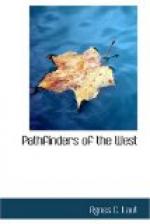But between love of the wilds and love of barbarism is a wide difference. He had not been back for two weeks when that glimpse of crude civilization at Orange recalled torturing memories of the French home in Three Rivers. The filthy food, the smoky lodges, the cruelties of the Mohawks, filled him with loathing. The nature of the white man, which had been hidden under the grease and paint of the savage—and in danger of total eclipse—now came upper-most. With Radisson, to think was to act. He determined to escape if it cost him his life.
Taking only a hatchet as if he were going to cut wood, Radisson left the Indian lodge early one morning in the fall of 1653. Once out of sight from the village, he broke into a run, following the trail through the dense forests of the Mohawk Valley toward Fort Orange. On and on he ran, all that day, without pause to rest or eat, without backward glance, with eye ever piercing through the long leafy vistas of the forest on the watch for the fresh-chipped bark of the trees that guided his course, or the narrow indurated path over the spongy mould worn by running warriors. And when night filled the forest with the hoot of owl, and the far, weird cries of wild creatures on the rove, there sped through the aisled columns of star light and shadow, the ghostly figure of the French boy slim, and lithe as a willow, with muscles tense as ironwood, and step silent as the mountain-cat. All that night he ran without a single stop. Chill daybreak found him still staggering on, over rocks slippery with the night frost, over windfall tree on tree in a barricade, through brawling mountain brooks where his moccasins broke the skim of ice at the edge, past rivers where he half waded, half swam. He was now faint from want of food; but fear spurred him on. The morning air was so cold that he found it better to run than rest. By four of the afternoon he came to a clearing in the forest, where was the cabin of a settler. A man was chopping wood. Radisson ascertained that there were no Iroquois in the cabin, and, hiding in it, persuaded the settler to carry a message to Fort Orange, two miles farther on. While he waited Indians passed the cabin, singing and shouting. The settler’s wife concealed him behind sacks of wheat and put out all lights. Within an hour came a rescue party from Orange, who conducted him safely to the fort. For three days Radisson hid in Orange, while the Mohawks wandered through the fort, calling him by name.
Gifts of money from the Jesuit, Poncet, and from a Dutch merchant, enabled Radisson to take ship from Orange to New York, and from New York to Europe.
[Illustration: Fort Amsterdam, from an ancient engraving executed in Holland. This view of Fort Amsterdam on the Manhattan is copied from an ancient engraving executed in Holland. The fort was erected in 1623 but finished upon the above model by Governor Van Twiller in 1635.]




